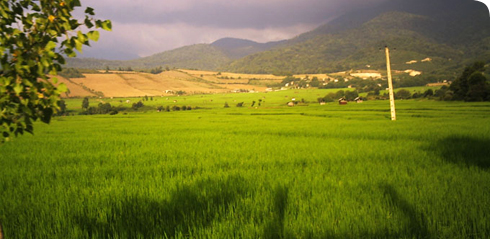Uses
Azolla has been used for centuries as a green fertiliser in rice paddy fields in Asia, especially in Vietnam and south east China - it is mentioned in a Chinese book of agricultural techniques from 540 AD.
Thanks to the cyanobacterium (Anabaena azollae) that lives in the leaves and fixes atmospheric nitrogen, it is rich in nitrogen and greatly improves rice yields. Azolla pinnata was used in China until 1977 when A. filiculoides was introduced. A. filiculoides proved resistant to insect attack and, as it tolerates colder conditions, it is suitable for use in northern areas and for late winter and early spring rice crops.
The Azolla can be utilised as a fertiliser in a number of ways. It can be:
- grown as a monocrop and incorporated into the soil before planting the rice
- grown as a companion crop among the rice
- harvested from ponds or other fields and applied as a mulch to the soil
Azolla biofertiliser has many advantages over chemical nitrogenous fertilisers. These advantages include:
- it is cheap
- it is sustainable
- the soil structure is improved
- additional nutrients are supplied to the crop
- there is no run-off to harm the environment
Azolla also has other uses, for example it can be:
- a nitrogen fertiliser on other crops, for example taro (flooded fields) and wheat (dry land)
- a livestock feed supplement, for cattle, chickens, ducks and fish, for example
- a water purifier:
- Azolla’s capacity to accumulate high concentrations of metals from the environment enables its use to remove heavy metals eg lead and zinc from waste water
- it can be used to remove nitrogenous compounds from waste water
- cultivated for ornamental purposes, particularly because of the seasonal red colouration
- used to control mosquitoes by covering the water surface with thick mats to prevent adults laying eggs and larvae from breathing, hence the American name mosquito fern
